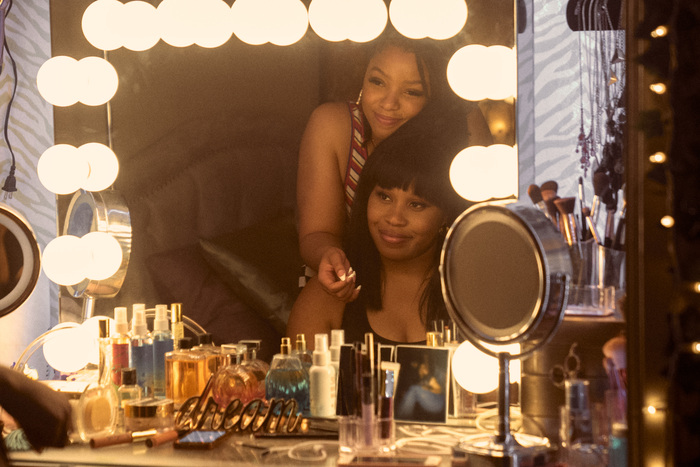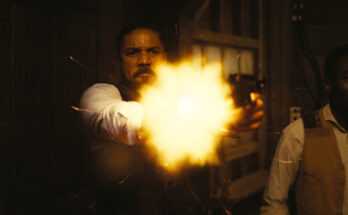Want to hear more from the actors and creators of your favorite shows and films? Subscribe to The Cinema Spot on YouTube for all of our upcoming interviews!
Managing editor & film and television critic with a Bachelor's of Arts in English Literature with a Writing Minor from the University of Guam. Currently in graduate school completing a Master's in English Literature.
Over four months following the end of his FX series, Atlanta, Donald Glover returns with a new television program, Swarm. Co-created with Janine Nabers, this horror thriller comedy-drama streaming series centers on the dangers of toxic fandom, otherwise known as “stan culture”. The term, “stan”, emanates from the eponymous narrative song written and performed by the rap artist, Eminem, in 2000. Since then, the term has pretty much stuck yet has been popularized more and more as the years have gone by.
Swarm follows this trend of people who claim to be “huge fans” of some kind of individual. The series plays around with bee-related terms, including the “hive mind”, which I previously found to hold weight HBO’s Westworld Season 4. Of course, this program plays inside the waters of how we as a society precisely and accurately define fandom culture. Especially when it comes to fanbases such as filmmaker Zack Snyder’s DC Extended Universe or the “Barbz” of Nicki Minaj’s fan community, you can never be too careful. The series takes inspiration from Beyoncé’s pop star background and establishes a narrative of soul-searching. What Nabers and Glover attempt to do, then, is extrapolate on such dangers and present what has been, what is, and what could be.
In this review, I will be discussing Nabers and Glover’s Prime Video series, Swarm. There will be no major spoilers present, as the title of this article suggests. Nonetheless, please read ahead at your own discretion.
Please note that I have seen the pilot episode three times and the rest of the series at least twice each ahead of its release. ALSO, Trigger Warning: depression, self-harm, some nudity.

Swarm Synopsis and Episode Information
According to Amazon Studios, here is the synopsis for Swarm.
From co-creators and executive producers Janine Nabers and Donald Glover, ‘Swarm’, set between 2016-2018, follows Dre (Dominique Fishback), an obsessed fan of the world’s biggest pop star who sets off on an unexpected cross-country journey.
Amazon Studios Press
The episode titles from the pilot to the finale—along with the runtimes, the writers, and the directors thereof—for the series are as follows.
- Pilot/ “Stung” (35:04)—teleplay by Janine Nabers, story by Janine Nabers & Donald Glover, & directed by Donald Glover
- “Honey” (33:40)—written by Jamal Olori, dir. by Adamma Ebo (Honk for Jesus. Save Your Soul., Atlanta Season 4 Episode 3)
- “Taste” (28:39)—written by Janine Nabers & Kara Brown (She-Hulk: Attorney at Law), dir. by Adamma Ebo
- “Runnin’ Scared” (37:39)—written by Ibra Ake and Stephen Glover and dir. by Ibra Ake
- “Girl, Bye” (26:11)—teleplay by Janine Nabers and Malia Ann, story by Nabers and Ake, and dir. by Ibra Ake
- “Fallin’ Through the Cracks” (34:29)—written by Karen Joseph Adcock (BoJack Horseman, How I Met Your Father Season 1, The Bear, Atlanta) and Stephen Glover, and dir. by Stephen Glover
- Finale/ “Only God Makes Happy Endings” (33:54)—written by Janine Nabers and dir. by Adamma Ebo
Discussion
Even with its episode count and runtime per episode, Swarm is a tough hill to traverse. If you are someone who consumes stories for their intricate details, then this series might be up your alley. Drew Daniels’s cinematography, the hair and makeup, White et al’s production designs, Frezza and Wallgren’s set decorations, the music curation, the writers’ strong themes of obsession, sameness, and otherness, and more are what make this title worth the watch.
The Direction of Photography and Aesthetics
On one hand, Daniels gives us a 360-degree panning movement of a house party. This showcases just a minuscule part of a vast world that our protagonist, Andrea “Dre” Greene (Dominique Fishback) does not feel too obligated to take a part in. It is also another thing that Daniels shows us primarily angles from Dre’s perspective along with the viewer’s perspective. When a character’s body falls onto a bed, we see another at the doorway. I also appreciate the 180-degree camera movement of one character entering a room. They hesitate at a 45-degree angle, then continue the panning to investigate a possible intrusion in the home.
In one episode, Dre and some girls have a meal at a dining table. Daniels’s camera captures them from the waist or the chest upward. Meanwhile, the rest of the frame, the top half, is mostly open space. This also allows the viewers to see the interior architecture, including the large portrait-length windows lined with light curtains. Even from the premiere episode, we see that Dre only lets certain people occupy the space around her. The only times when they free up space is when they become something of an obstacle to the character.
Dawson and Chapman’s costumes are sweet additions to the series that are not as mature as in Glover’s previous series, Atlanta. In the premiere episode, Dre wears a dazzling sparkling pink outfit, that leads her to a one-night stand with a familiar stranger. She then has a yellow and peach Honey sports bra and baby hairs on in the next episode. The character is pretty much the same throughout the series, but what is iconic of her are her transformative appearances.
Production
Additionally, Swarm consists of some lovely set pieces from Dre and Marissa’s (Chloe Bailey) apartment to an influencer’s home to a women’s empowerment housing property to a Houston mall to the sisters’ former home, and more. The meticulous attention to detail is not unlike what we have seen in Atlanta. Wallgren’s framed photos of Dre’s foster family on the wall of an upstairs hallway or Ayala’s pieces of this and that tacked onto a corkboard fill the frames of Daniels’s shots when necessary. A greater example is the house party scene earlier on.
Yet, even with or without these items and objects to give depth to the episodes’ scenes, there happen to be open spaces throughout. It seems to suggest that Dre’s world is empty and not complete and that things can take up space. However, that is all they are—things, nothing of substantial value.
Music and Sound
Comprised of at least a few different genres—from techno-pop to rap to some old-school R&B—, Uzowuru’s scoring can be quite Gothic. Oftentimes, it is difficult to distinguish whether Leahy and Moses’ tracks are original Ni’Jah music for the series or music from actual artists. The Ni’Jah music adds another layer to the narrative that it could be hard to focus on one bit of detail at a time. Glover lends his vocals to some tracks, which is not unlike him, having done so for Atlanta and his 2019 film, Guava Island.
Of course, there are some already-existing tracks present in the series, such as ScHoolboy Q’s “Studio”, Vagabon’s “Water Me Down”, Floyd Fuji’s “House Party”, SZA’s “Normal Girl”, or Larry Graham’s “Stand Up and Shout About Love”. I would not be surprised if some of the original music ends up being available to the public. Not to mention that some of these songs could tease Glover’s possible return as Childish Gambino (or Donald Glover as a musical artist name, which I would not mind).
Kimmel and Katona’s sound editing is also noteworthy, especially when pertaining to the Hive-related noises of the show. There is a lot of loud buzzing when it comes to the horror-thriller elements of the series. Notably, I love a certain echoing of a microphone and how that transitions to the faint buzzing of bees.
Addiction
“It’s Ni’Jah. You have to make sacrifices.”
—Andrea “Dre” Greene (Dominique Fishback) in ‘Swarm’ Episode 1, “Stung”
The difference between fans and stans is that the latter is more obsessed. It makes all the more sense to incorporate obsession into a horror thriller narrative. I mean, if you have not read Stephen King’s Misery or Rob Reiner’s 1990 adaptation, then maybe today is the day you begin to do so. Initially, I thought that, by a point, the series would focus on the seven deadly sins in some capacity. For the most part, that is true. Dre urges a man to cheat on his diet, which he admits to using to shed tons of weight—gluttony. (The man later learns that he cannot have his cake and eat it too.) Coincidentally, there is a glimpse of a verse of Scripture (Exodus 20:11) in a later episode. I am curious to know if the series’ seven-episode count plays into the idea of the number’s significance.
However, being the artist-obsessed fan that Dre is, Swarm mainly focuses on a mixture of wrath, lust, and pride. If we had to psychoanalyze further, then it could be that stans need something specific to maintain a feeling of being complete. Certain addictions, when given into, lead to pleasure or satisfaction. For Dre, her addiction to her favorite music artist is more than that. Her obsession is an over-idolization of Ni’Jah, placing her on a pedestal, and in fact, an unrealistic one.
Dre longs for someone specific to occupy her personal space, and the only other person to do this is a close loved one. Unfortunately, this external conflict becomes her internal conflict, leading to more maddening circumstances.
Sameness
Swarm provides some rather insightful truths about stan culture and what that means for people as human beings. I should start off by mentioning a subtle line about one of Ni’Jah’s songs and how it is apparently about a dead baby. This seems to tease the inclusion of a dead infant blood relative of Marissa’s. It is a moment that requires the viewer’s attention; a “blink and you will miss it” type of situation.
When it comes to sameness, we see Dre engaging in behavior that is very toxic-like of stans. This includes dealing with the doxxing of an Other (a Ni’Jah hater) through the help of Sames (stans). Although, it is important to note that not all fans are stans, and some fans do not agree with such actions. There are some social circles that Dre finds herself in but ultimately cannot belong to. In one episode, she is told:
Why are you running away? You know you’re free to go. We are all free to do whatever we want, but I need you to know… If you leave, we know everything about you. We know everything. We had an agreement when you gave us your bond. Your phone is accountability.
If we know Donald Glover and his commentary on the Internet, this seems to play into the fact that communities on social media are built from a sense of Sameness, including common interests. Dre can only be whole through a touchscreen, but that itself proves detrimental to her well-being.
Otherness
Akin to the concept of bees working to serve their queen, there seems to be a point that Nabers, Glover, and their writers’ room are making about stans and idols. In his critical text, The Expulsion of the Other: Society, Perception and Communication Today, South Korean-born German philosopher Byung-Chul Han cites “a destructive self-alienation” that many human beings are experiencing today. He asserts:
As soon. as the performance subject perceives itself … it gradually becomes alienated from it.
…
[A]rt preseves the uncanny.
…
The counterpart as the presence of the Other … degenerates into a mirror which mirrors oneself. … Today, we compete mercilessly for attention. For one another, we are shop windows vying for attention. … Digital communication in particular is designed to eliminate all distance. [Thus], we seek to bring the Other as close as possible [however] it causes them to disappear.
…
Social media do not necessarily foster a culture of discussion. They are often affect-driven. Shitstorms are an undirected flood of affects that does not form any public discourse. … Digital communication connects me, but simultaneously isolates me. It eliminates distance, but gaplessness alone does not create personal closeness. Without the presence of the Other, communication degenerates into an accelerated exchange of information. It creates no relationship, only connection.
Byung-Chul Han, ‘The Expulsion of the Other: Society, Perception and Communication Today‘, pages 46-7; 70; 72-3; 84-5
Ultimately, What is the Point?
What this specifically means for Dre is that she is undergoing numerous transformations throughout the series. She sees a connection to Ni’Jah, and in that, she does not desire a relationship with the artist. Rather, she is seeking an unobtainable relationship with someone else that she sees in Ni’Jah. That is what social media is doing.
By getting rid of distance, we are brought both closer and farther from the object of desire. We want something or someone to be the Same as us, which is impossible. With stan culture, toxic fans fight for that which they can never truly possess. Therefore, Sames can never really feel whole. In Dre’s case, there is a relationship with an Other that she cannot ever get a hold of, and that is what eats her from the inside.
What the inclusion of a deceased infant figure insinuates is that Ni’Jah possesses a paralleling commonality with Marissa. It is Dre’s gatekeeping, rather than a reputed protecting, of an individual away from outsider reach.
On the next page, I include cast and crew credits, along with my opinions on some key characters.





12 Comments on “Prime Video’s ‘Swarm’ Non-Spoiler Review – A Slow-Burning Study Of Stan Culture And Social Sicknesses”